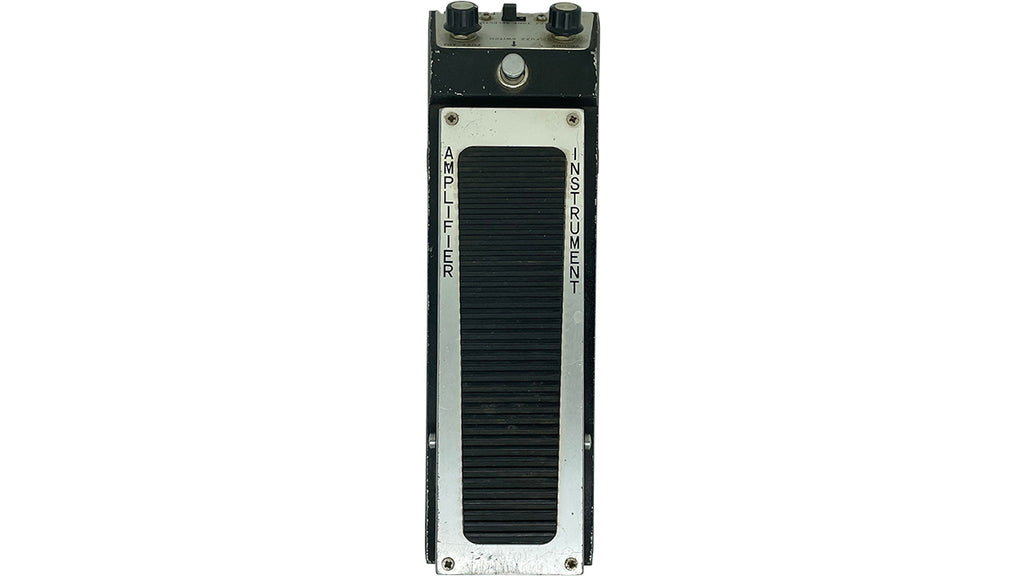Shin-Ei Companion 6TR Fuzz Wah

If I had unlimited dough and space, and had to start a new cabinet from scratch, 75 percent of it would be fuzz pedals. Like any other red-blooded effects fanatic, I love fuzz pedals and the sheer variety of them. Some are super simple, consisting of just six parts—the old DIY staple, the Bazz Fuss, is one. On the other hand, some fuzzes like our Giygas contain over 90 parts. The effect is variations on a theme; sweet, saturated chewy slabs of tone that interact with other pedals and guitar controls in various ways. And when I say various, I mean hundreds. Thousands, even. There are more fuzz pedals on the market than perhaps any other type.
Many of these fuzz units, even starting at the near-beginning, are retoolings of just a handful of classic designs. Effects guru Roger Mayer once said of the Fuzz Face: “Essentially, a transistor is a three-terminal device. There’s not many ways you can connect up three terminals, is there? Most of the elements of the circuit can be seen in any textbook from 1965. They’re all written down. You couldn’t patent it. It’s impossible to patent an obvious way of connecting up two transistors.” Luckily, fuzz tinkerers came up with solutions to innovate with all sorts of transistor numbers. Shin-Ei was one such company, whose device model numbers often hinted at the number of transistors found therein. One such is this, the Shin-Ei Companion 6TR Fuzz Wah.

Shin-Ei started as Honey, with that name being a little more obscure to the casual effects fan, but just as important. Honey released several ultra-expensive units such as the Special Fuzz, Psychedelic Machine and Resly Tone [sic]. When Honey became Shin-Ei, it produced several devices that would become household names, such as the Uni-Vibe and Super Fuzz. Though the lineage and procurement of these products is somewhat complicated, they became instant classics, heard on thousands of rock records.
But Shin-Ei released so many more effects than those, and a fair number of them were fuzz pedals. Apart from the Super Fuzz mentioned earlier, Shin-Ei released the FY-2 and FY-6 pedals under the name Companion.
Though the FY-2 circuit was quickly etched into fuzz canon, becoming synonymous with the brand Companion, the FY-6 eventually became the Univox Super Fuzz after some drama involving importers and such. Eventually, the FY-6 and thusly the Super Fuzz ended up in the 8TR, a hybrid fuzz-and-wah unit. In the 8TR’s case, this means six transistors for the Super Fuzz and two for the wah side—a Companion WT-1, also known as the Univox Uniwah.
But if the 8TR means a six-transistor fuzz, then someone needs to explain the 6TR in a hurry. This circuit is one of the lost great fuzz devices; nobody famous uses it (that I know of) and it’s only available with an attached wah device.
Topologically, it’s not quite a Super Fuzz circuit, though it does share similarities. The octave-up effect is still present, courtesy of the phase splitter and differential pair. There’s a gain stage up front in both devices, but it’s significantly more deconstructed in the 6TR, making the upper octave bloom a bit better at the sacrifice of more chainsaw-like brute strength. Perhaps more interestingly though, the Fuzz (Adj.) control is derived from the FY-2 circuit, in which the control pans between the first gain stage by itself and the whole shebang together, including the phase inverter, differential pair, clipping diodes and unique filtering. Perhaps most important is the tone one gets when the required battery is in less-than-perfect health. In a Super Fuzz, it sounds good, but in the 6TR, it sounds exceptional. Notes decay in a much more unique way and it adds quite a bit of spice to the circuit.

One important aspect of the 6TR is what it represented to the hordes of burgeoning guitarists in the ‘90s. While vintage fuzz devices were in much greater supply in the ‘90s, they were still heralded as pricier collectibles. When blue collar musicians went shopping for them, certain “undesirable” units cost far less than equivalent counterparts. Music stores couldn’t give away “IC” Big Muffs back then, so they were snatched up by hungry musicians. Even today, the 8TR can be found for far cheaper than an actual Super Fuzz. And to that end, the 8TR was adopted by Jesus and Mary Chain, for similar suspected reasons. And it’s also the reason that a young Kurt Cobain had a clone of the 8TR’s fuzz explicitly built for him by a guitar tech. Thankfully, the schematic is glued to the inside of the pedal’s backplate.
It also goes without saying that the 6TR has quite possibly the sleekest treadle-based two-effect enclosure ever created. Just slightly larger than a standard wah shell, the 6TR places one switch under the treadle (wah) and one right in front of the toe position to activate the fuzz, while all controls sit on the front face. Style, function and a relatively low price tag—what’s not to love?
